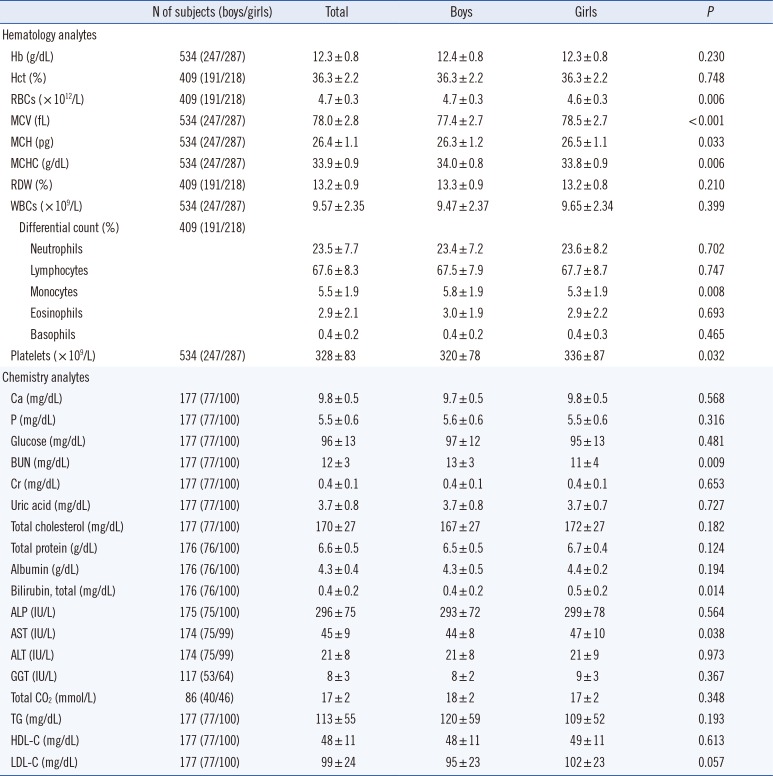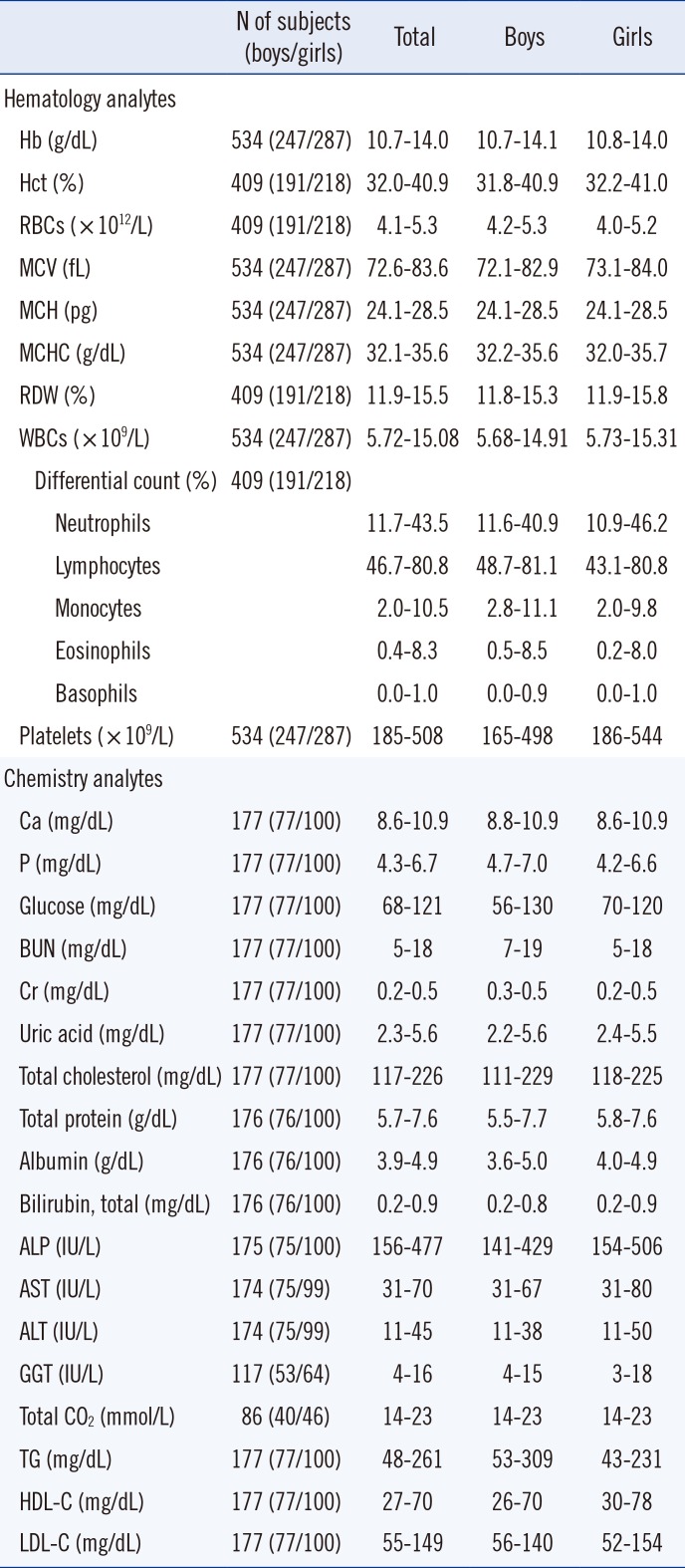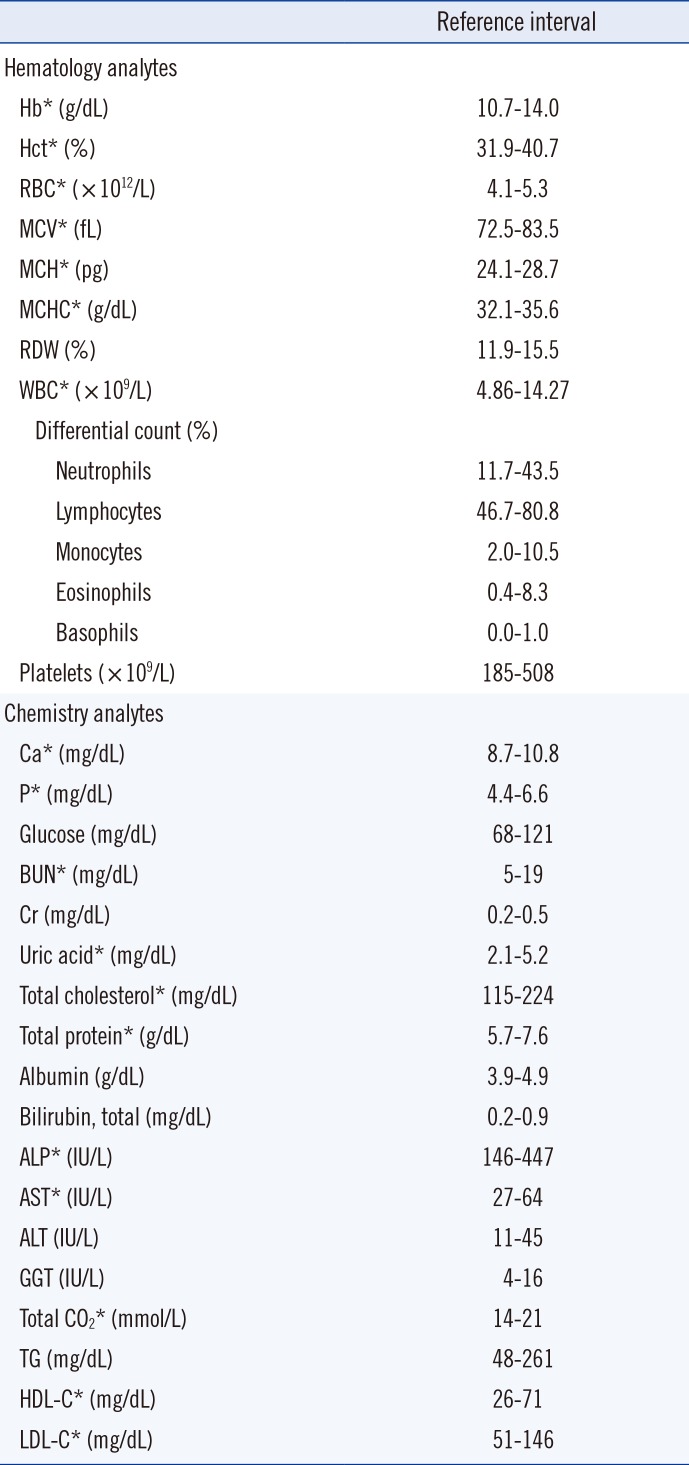1. Shaw JL, Binesh Marvasti T, Colantonio D, Adeli K. Pediatric reference intervals: challenges and recent initiatives. Crit Rev Clin Lab Sci. 2013; 50:37–50. PMID:
23656169.
2. Horowitz GL, Atlaie S, Boyd JC. Defining, establishing, and verifying reference intervals in the clinical laboratory; approved guideline. C28-A3c. Wayne, PA: National Committee for Clinical Laboratory Standards;2010.
3. Ridefelt P, Hellberg D, Aldrimer M, Gustafsson J. Estimating reliable paediatric reference intervals in clinical chemistry and haematology. Acta Paediatr. 2014; 103:10–15. PMID:
24112315.
4. Jung B, Adeli K. Clinical laboratory reference intervals in pediatrics: the CALIPER initiative. Clin Biochem. 2009; 42:1589–1595. PMID:
19591815.
5. Ceriotti F. Establishing pediatric reference intervals: a challenging task. Clin Chem. 2012; 58:808–810. PMID:
22377530.
6. Soldin SJ, Brugnara C, editors. Pediatric reference intervals. 6th ed. Washington, DC: AACC Press;2007.
7. Arceci RJ, Hann IM, editors. Pediatric hematology. 3rd ed. Massachusetts: Wiley-Blackwell;2006.
8. Male C, Persson LA, Freeman V, Guerra A, van't Hof MA, Haschke F. Prevalence of iron deficiency in 12-mo-old infants from 11 European areas and influence of dietary factors on iron status (Euro-Growth study). Acta Paediatr. 2001; 90:492–498. PMID:
11430706.
9. Dallman PR, Siimes MA, Stekel A. Iron deficiency in infancy and childhood. Am J Clin Nutr. 1980; 33:86–118. PMID:
6986756.
10. Baker RD, Greer FR. Diagnosis and prevention of iron deficiency and iron-deficiency anemia in infants and young children (0-3 years of age). Pediatrics. 2010; 126:1040–1050. PMID:
20923825.
11. Lang T. Reference intervals: the GB data. Clin Biochem. 2011; 44:477–478. PMID:
22036334.
12. Cho SM, Lee SG, Kim HS, Kim JH. Establishing pediatric reference intervals for 13 biochemical analytes derived from normal subjects in a pediatric endocrinology clinic in Korea. Clin Biochem. 2014; 47:268–271. PMID:
25241678.
13. Adeli K, Raizman JE, Chen Y, Higgins V, Nieuwesteeg M, Abdelhaleem M, et al. Complex biological profile of hematologic markers across pediatric, adult, and geriatric ages: establishment of robust pediatric and adult reference intervals on the basis of the Canadian Health Measures Survey. Clin Chem. 2015; 61:1075–1086. PMID:
26044509.
14. Blasutig IM, Jung B, Kulasingam V, Baradaran S, Chen Y, Chan MK, et al. Analytical evaluation of the VITROS 5600 Integrated System in a pediatric setting and determination of pediatric reference intervals. Clin Biochem. 2010; 43:1039–1044. PMID:
20501331.
15. Chan MK, Seiden-Long I, Aytekin M, Quinn F, Ravalico T, Ambruster D, et al. Canadian Laboratory Initiative on Pediatric Reference Interval Database (CALIPER): pediatric reference intervals for an integrated clinical chemistry and immunoassay analyzer, Abbott ARCHITECT ci8200. Clin Biochem. 2009; 42:885–891. PMID:
19318027.
16. Kulasingam V, Jung BP, Blasutig IM, Baradaran S, Chan MK, Aytekin M, et al. Pediatric reference intervals for 28 chemistries and immunoassays on the Roche cobas 6000 analyzer--a CALIPER pilot study. Clin Biochem. 2010; 43:1045–1050. PMID:
20501329.
17. Colantonio DA, Kyriakopoulou L, Chan MK, Daly CH, Brinc D, Venner AA, et al. Closing the gaps in pediatric laboratory reference intervals: a CALIPER database of 40 biochemical markers in a healthy and multiethnic population of children. Clin Chem. 2012; 58:854–868. PMID:
22371482.
18. Zierk J, Arzideh F, Rechenauer T, Haeckel R, Rascher W, Metzler M, et al. Age- and sex-specific dynamics in 22 hematologic and biochemical analytes from birth to adolescence. Clin Chem. 2015; 61:964–973. PMID:
25967371.
19. Ridefelt P, Aldrimer M, Rödöö PO, Niklasson F, Jansson L, Gustafsson J, et al. Population-based pediatric reference intervals for general clinical chemistry analytes on the Abbott Architect ci8200 instrument. Clin Chem Lab Med. 2012; 50:845–851. PMID:
22628328.
20. Aldrimer M, Ridefelt P, Rödöö P, Niklasson F, Gustafsson J, Hellberg D. Reference intervals on the Abbot Architect for serum thyroid hormones, lipids and prolactin in healthy children in a population-based study. Scand J Clin Lab Invest. 2012; 72:326–332. PMID:
22724627.
21. Aldrimer M, Ridefelt P, Rödöö P, Niklasson F, Gustafsson J, Hellberg D. Population-based pediatric reference intervals for hematology, iron and transferrin. Scand J Clin Lab Invest. 2013; 73:253–261. PMID:
23448533.
22. Hilsted L, Rustad P, Aksglaede L, Sørensen K, Juul A. Recommended Nordic paediatric reference intervals for 21 common biochemical properties. Scand J Clin Lab Invest. 2013; 73:1–9. PMID:
23013046.
23. Rödöö P, Ridefelt P, Aldrimer M, Niklasson F, Gustafsson J, Hellberg D. Population-based pediatric reference intervals for HbA1c, bilirubin, albumin, CRP, myoglobin and serum enzymes. Scand J Clin Lab Invest. 2013; 73:361–367. PMID:
23581477.
24. WHO. Haemoglobin concentrations for the diagnosis of anaemia and assessment of severity. Vitamin and Mineral Nutrition Information System. Geneva: WHO;2011. Accessed on Jan 2016. (WHO/NMH/NHD/MNM/11.1).
http://www.who.int/vmnis/indicators/haemoglobin.pdf.
25. Andersson O, Domellöf M, Andersson D, Hellström-Westas L. Effect of delayed vs early umbilical cord clamping on iron status and neurodevelopment at age 12 months: a randomized clinical trial. JAMA Pediatr. 2014; 168:547–554. PMID:
24756128.
26. Burke RM, Leon JS, Suchdev PS. Identification, prevention and treatment of iron deficiency during the first 1000 days. Nutrients. 2014; 6:4093–4114. PMID:
25310252.
27. Harit D, Faridi MM, Aggarwal A, Sharma SB. Lipid profile of term infants on exclusive breastfeeding and mixed feeding: a comparative study. Eur J Clin Nutr. 2008; 62:203–209. PMID:
17327867.
28. Thorsdottir I, Gunnarsdottir I, Palsson GI. Birth weight, growth and feeding in infancy: relation to serum lipid concentration in 12-month-old infants. Eur J Clin Nutr. 2003; 57:1479–1485. PMID:
14576762.
29. Qasem W, Fenton T, Friel J. Age of introduction of first complementary feeding for infants: a systematic review. BMC Pediatr. 2015; 15:107. PMID:
26328549.
30. Capozzi L, Russo R, Bertocco F, Ferrara D, Ferrara M. Diet and iron deficiency in the first year of life: a retrospective study. Hematology. 2010; 15:410–413. PMID:
21114904.








 PDF
PDF ePub
ePub Citation
Citation Print
Print


 XML Download
XML Download